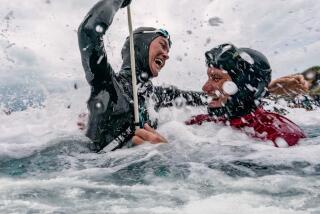Aquaman : Deep Diver Ferreras Is a Breath of Fresh Air Who Rarely Needs One
- Share via
Francisco “Pipin” Ferreras has long lost sight of the surface. The ocean is black. The pressure seems to be squeezing the life out of him.
But down he goes, a little deeper, riding a sled attached to a cable into what seems a vast and bottomless abyss, holding his breath. And holding, and holding. . . .
The pressure is so great, the blood in his arms and legs is being forced to his chest and brain. It flows into his lungs. The gulp of air he stole at the surface more than a minute ago is all but gone.
Down he goes, a little deeper. . . .
Below 300 feet he finds that no matter how hard he blows he can no longer relieve the pressure building in his ears, so he removes his nose plug and lets water flow into and through his head, forcing what little air there is in his sinus cavities to his ears, relieving the pressure.
A little deeper. . . .
To 400 feet and beyond. Into an eerie world getting blacker, colder and lonelier by the second. A world too deep for all but the most experienced of scuba divers, much less a man with a single breath. World War II submarines would have collapsed under the pressure at this depth.
Yet with the weight of an ocean upon him, Ferreras, 6 feet 3 and 220 pounds, continues downward.
His heart is down to fewer than 10 beats a minute. He can’t see a thing. He tries to keep a clear head, fighting the urge to panic, knowing that one false move, one delay, could be fatal.
He passes through a narrow crevasse and, finally, to the end of the cable, 428 feet--or about the height of a 30-story building. Deeper than anyone has ever gone without tanks, and much deeper than all but a handful of breath-hold divers will ever dream of going.
And at the moment, much deeper than Ferreras wants to be. He craves the warmth and light of the sun, but most of all to fill his starving lungs with precious air.
His ascent begins immediately and dramatically: He pulls the tab on a self-inflating balloon and races toward the surface at a speed of 13 feet per second.
The ocean changes back to the beautiful blue he knows so well, and it’s getting bluer and more beautiful by the second.
A little higher. . . .
The blood leaves his lungs and returns to his arteries, where it belongs.
With no need to decompress, having not been breathing compressed air, he flies past his support team--there are six scuba divers, positioned at various depths to monitor his progress--one by one, finally breaking the surface amid cheers and applause of hundreds who have come to watch him go down and come back up, dead or alive.
Ferreras had been underwater for 2 minutes 38 seconds. “Two eternal minutes,” he says. “Two irreplaceable, incredible, disturbing minutes. . . . Two minutes that have made me the deepest man in the world.”
*
Ferreras’ record-setting breath-hold dive last month off Cabo San Lucas set him farther apart from the others who do what he does--all of a dozen or so.
Indeed it is a select few who do this sort of thing--competing around the world and trying occasionally to break each others’ record--and for good reason: Only a select few have what it takes, physically and mentally, to plunge to such depths on a single breath.
Ferreras, 34, takes the sport of deep diving very seriously, and has traced it to the turn of the century, when sponge fisherman Yorgos Haggi Statti, “a sickly, rickety, insignificant man,” offered to recover an anchor lost by an Italian navy vessel about 250 feet below the surface of the Aegean Sea. As payment, he asked for five pounds sterling and permission to be able to fish with dynamite, an advantage reserved for the navy.
The feeble diver, despite strong skepticism on the part of the captain and crew, made three dives, located the anchor and slipped a rope through its eye so it could be retrieved.
According to Ferreras’ research, French and Italian divers during World War II were trained “to go underwater for great distances, while holding their breath, to locate mines or to place explosives underneath Nazi vessels located in the Mediterranean.”
Ferreras can list all the modern-day deep-dive records, from Raimundo Bucher’s 98-foot plunge in 1949 to the lengthy reign of the great Italian diver, Enzo Maiorca, who made it to 204 feet in 1966.
Today, Ferreras is the reigning champion, no surprise considering his background.
He was practically raised in the water, growing up in Cuba. He could swim before he could walk. The ocean put food on his family’s table, money in his pocket.
And for these reasons, as he got older, spear gun in hand, he journeyed ever deeper into the bountiful world surrounding his homeland.
By the time he was 12 he could free-dive more than 100 feet. In 1987, while hunting fish for a resort, before a group of vacationing Italian journalists, he speared a grouper at 200 feet.
He was subsequently invited to a competition in Italy and won it, setting a world record at 343 feet. In 1989, he became the first to dive deeper than 100 meters (360.8 feet).
As he went deeper, he became more interested in the effects the dives might have on his body.
So have scientists, who might want to consider reclassifying Ferreras as a marine mammal. His lungs can hold more than eight liters of air, twice that of the normal adult. He says he can hold his breath at the bottom of a swimming pool for nearly nine minutes.
Last November, a team of scientists studied the burly, bald-headed diver during a series of dives to 375 feet in one day off Miami Beach. (Ferreras defected to Florida three years ago.)
One doctor took blood samples before and after the dives and said that, at great depths, the spleen is squeezed, which triggers an increase in red cells and the hemoglobin level, which might improve the oxygen capacity in the blood stream.
An EKG machine monitored Ferreras’ heartbeat, which prompted oceanographer Kim McCoy to tell the Palm Beach Post: “As a clinician, if I saw those types of slowing of the heart and irregularity, we would have started coding him. It would have been an emergency.”
Dr. James Loewenherz, associate medical director of hyperbaric medicine at Mercy Hospital in Miami, told the Post that as Ferreras descends, the pressure triggers a primitive reflex similar to that experienced by whales and seals when they dive.
It causes his heart rate to slow and the blood in his extremities to be pushed toward his chest and brain. The pressure eventually pushes the air in his lungs into his sinuses and ears, which then dissolves in his blood and tissues. The flow of blood into his lungs prevents their total collapse.
“He’s probably very close to what we would consider to be dead,” Loewenherz said. “He is very much a survivor because of his training . . . but should something detain him at 400 feet or even 200 feet, he would be at great risk of drowning.”
Ferreras credits extensive training of both body and mind--he once traveled to India to study with a yogi, and has also studied Buddhism.
And he is confident he can go even deeper than 428 feet, though even he acknowledges that he must set a limit for himself, or risk going too far.
“I’m going to go to 500 feet, and then I’m going to retire,” he says.
NOTEWORTHY
New salmon regulations: The recently announced “emergency action,” designed to protect the endangered winter-run Chinook (or king) salmon, will have a big impact on Northern California anglers in that it shortens the season as much as two months, increases from 20 to 24 inches the size of fish that can be kept and, beginning July 1, imposes strict gear restrictions--such as an increased hook size that, it is hoped, will result in fewer fish swallowing the hook.
But Southland anglers--those below Point Conception--who have much less impact on the fishery, will be less regulated and may hardly notice the changes. Their season will also be shortened by two months, ending Aug. 26, but whatever salmon that venture into Southland waters are long gone by then anyway. And southern anglers can keep only fish 24 inches or longer, and come July 1 that will increase to 26 inches.
The fish caught locally are usually bigger than those taken up north, having gorged themselves on the way down. But then, fishermen here may not have to worry about the new regulations at all. Unlike last year at this time, there is no salmon bite to speak of.
Flatfish fanatics: About 1,800 anglers are expected to compete for prizes--among them trips to Alaska and Baja--in this weekend’s Santa Monica Bay Halibut Derby. Those wanting to elbow their way in for the two-day event--at a cost of $70 for derby and banquet, $40 for derby only and $15 per person per team--can call (310) 450-5131 for details.
‘Two eternal minutes. Two irreplaceable, incredible, disturbing minutes. . . . Two minutes that have made me the deepest man in the world.’


